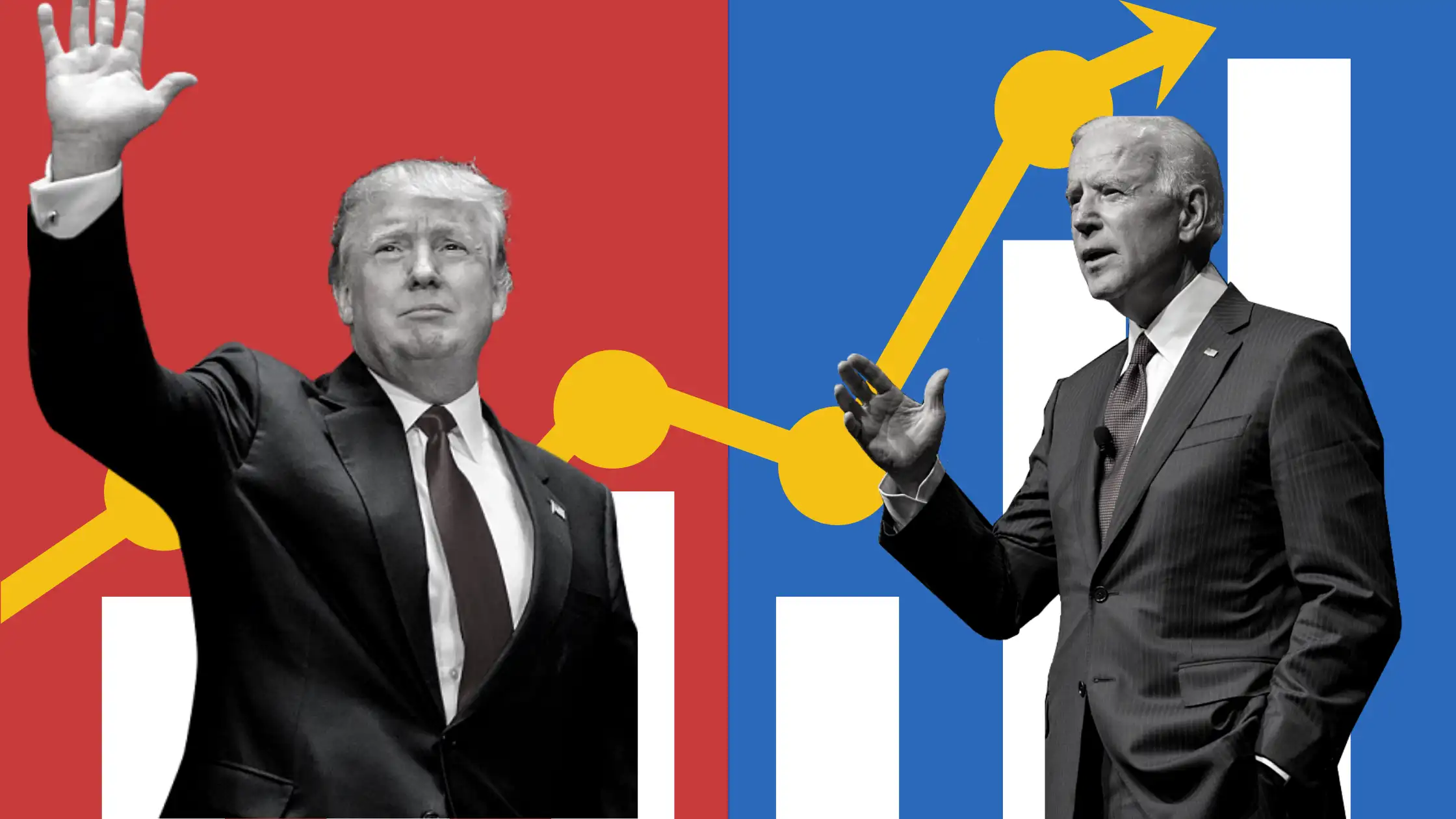Analysis
Sonia Guerrero
Can you trust the electoral polls this 2020? How are they to be interpreted?
- Following the results of the 2016 US presidential election, the credibility of electoral polls was called into question. Can we trust them in 2020?

Following the results of the 2016 US presidential elections, the credibility of electoral polls was called into question.
Voting intention surveys are research tools that allow collecting data such as opinions and attitudes from a group of people through a questionnaire that is applied to them. This tool has been widely used to investigate political behavior, political culture, and to try to explain the levels of electoral participation.
This type of investigation had its origin in the American School of Political Science, and therefore, the voters of that country were the first to be studied. Although initially the assumptions established by this type of study were based mainly on the US electoral system, over the years they were adapted to study different realities, in other countries with different types of political regimes.
Despite the diversity of democracies that coexist in the world, there are universal factors that have an influence on political behavior, and that are therefore taken as variables to formulate the questions that appear in electoral surveys. There are sociological and economic variables, such as age, occupation, sex, educational level, income, and race; there are psychological variables, such as political attitudes and willingness to participate; and lastly, there are the institutional variables, such as the political and electoral systems studied, the current political climate, alternative voting techniques, and political campaigns.
Electoral polls in the United States
The rigorous analysis of the precision that the polls have had over time provides evidence on the performance of the electoral polls. National polls on presidential elections are more accurate now than they were a few decades ago. Since the year 2000, the average absolute error range in this type of survey has been between 2 and 3 percentage points, which historically speaking is a good margin of error [1].
This chart shows the average statistical error in national presidential polls from 1936 to 2016.
Retrieved from Pew Research Center.
The polls in the 2016 presidential elections: Expectation vs reality
During the 2016 presidential campaign, most national and state election polls projected Hillary Clinton, the Democratic nominee, to defeat Donald Trump. Based on opinion polls, some election forecasters put the probability of Clinton winning at between 70% and 99%; In addition, she was listed as the great favorite to win in several states such as Pennsylvania and Wisconsin, where she, in the end, won Donald Trump.
In retrospect, it is clear that the polls underestimated the level of support that Trump had, in addition to the levels of voter participation that occurred in that process. The forecasters who predicted Hillary's electoral success weren't entirely wrong, however, as national polls predicted that she would win the popular vote, on average, by 3%.
Finally, she did win the popular vote with a 2% advantage over Trump; but in the United States it is not enough for a candidate to win the popular elections to become president, rather the result that determines who wins is the one obtained through the Electoral College (a process where 538 delegates are elected who vote for one of the presidential candidates [2]).
The process to elect the president of the United States is complex, in almost every state, the candidate who has the highest number of votes wins all the delegates of that state. The candidate who receives the most Electoral College votes (270 or more) wins the election.
For the fifth time in US history, the 2016 election produced a mismatch between the national popular vote and the Electoral College result. Hillary Clinton, won with nearly 2.9 million more popular votes than Trump, but still lost the election. Trump carried states efficiently, by very narrow margins in some cases, converting 46% of all votes cast to 56.5% of the Electoral College [3].
This map presents the number of delegates participating in the designated Electoral College for each state.
Source: Share America [4].
Due to Trump's inadvertent and close victories through the popular vote in swinger states (which have swung from one party to another in the last elections), the current president won a majority of Republican delegates in the Electoral College. That is why one should not rely on national electoral polls, but rather pay more attention to state polls, and especially analyze those from swing states.
Why didn't the swing state polls predict Trump's win in 2016?
Toward the end of the 2016 election campaign, final polling averages underestimated Trump's margin of support over Clinton; in swing states support was underestimated by more than five percentage points, such as North Carolina (5.3), Iowa (5.7), Minnesota (5.7), Ohio (6.9), and Wisconsin (7.2) ( these percentages were calculated by taking the difference between the speculated results in the surveys carried out on the day of the vote and the official results) [5].
As a consequence of the results in that electoral process, the credibility of the polls was strongly criticized, especially since there are currently various methodological approaches to interpret and collect information. The polling agencies undertook the task of finding out which variables were overlooked in 2016. In this review, the agencies found old methodological errors, and new variables, typical of the circumstances that characterized that electoral process.
Mentioned below are the variables that influenced the results of the 2016 surveys, followed by general considerations that must be taken into account when interpreting the results of this type of survey.
- The characteristic variables of 2016:
The “shy trumpers”: A widely accepted theory indicates that, within the universe of people surveyed, there were those who intended to vote for Trump; but because his xenophobic and racist speech is considered socially undesirable, this segment of respondents did not admit his true intentions. Some analysts have surmised that Trump supporters are more likely to deny that they are if the poll is administered in person, or by phone; it was believed that through online surveys, Trump supporters could come clean. That is why the agency Politico and morning carried out an experiment to test if that was the case; overall, there was little indication that this was true. However, they did find data suggesting higher-income, college-educated voters might have been more likely to support Trump online.
Higher voter turnout in swing states: Despite the fact that turnout in 2016 (58.1% of citizens over 18 years of age) was lower than that of 2008 (61.6%), voter turnout increased in states like Florida, Michigan, and North Carolina, that is, the swing states [6]. Polling agencies assumed that some voters registered on the electoral roll, but who had not voted in a decade, would not vote in the 2016 election; however, they did, and their votes were decisive in Trump's victory.
Trump's populist campaign appealed to sectors that don't usually vote: In 2016, Trump successfully mobilized white voters who are becoming a smaller portion of the American electorate and typically have low rates of electoral participation. These were mostly non-urban voters and those with lower levels of education
Undecided Voters: Polling agencies tracked voting intention trends throughout the election campaign. However, they didn't do any more polling in the week leading up to the election, and that's when a lot of people decided who to vote for.
- General considerations about the blind spots of electoral polls that must be kept in mind when interpreting them:
- Non-response bias: The size and composition of the samples is extremely important, since it is possible that they are not representative of the universe of the population studied. The population with higher income, educational level, and civic commitment are more prone to respond to electoral surveys, and therefore, are usually overrepresented in the surveys; To avoid this, agencies must perform calculations to determine how many respondents with these characteristics should be in the sample, to ensure that the sample is as representative as possible. On the contrary, the population with a lower educational level, lower income and less interest in politics, is usually not willing to answer the surveys, and very possibly does not vote. But there is always the possibility that their level of electoral participation is higher than expected, even if they have not left a trace of their preferences in the surveys carried out before the election; this was the case in 2016. In fact, it is speculated that the frustration and anti-institutional feelings that characterized a part of Trump's supporters could have been related to the reluctance to answer surveys; while Democratic sympathizers were overrepresented [7].
- Prospective voter error: Although some people answer in the polls that they intend to vote, this does not mean that they actually do. Agencies look for evidence of a respondent's historical political involvement to determine whether or not the respondent is likely to vote.
- The respondent may simply not tell the truth.
What do the surveys indicate this 2020?
The circumstances under which this electoral process will take place create greater uncertainty regarding the results that will be forthcoming. The COVID-19 pandemic and the controversies surrounding the administration of the elections will put the accuracy of the polls to the test, since some official statistics already show that many plan to vote in alternative ways, and early by mail or in person. Access to these alternative forms of voting varies greatly within the United States, making the political consequences difficult to anticipate. Trump and his Republican supporters have raised questions about the validity and security of voting by mail.
A recent opinion poll showed that Democrats are much more likely to trust voting by mail compared to Republicans (72% to 22%). For their part, Democrats and other groups are filing numerous lawsuits to help ensure that voting by mail remains a widely available voting method [8].
The possibility of a greater electoral participation this year than in previous years is not ruled out, which could harm the accuracy of the polls.
As of today, October 17, Biden is leading the polls; he has led them since the beginning of the year, and the percentage of voters who say they intend to vote for him has fluctuated relatively little.
How are Biden and Trump doing in the national polls? The lines in this graph represent weighted averages, the points represent surveys (%).
Graph recovered from “The Financial Times” [9].
On the other hand, the polls conducted in the swing states show that Biden leads, although by advantages no greater than 9.5%.
Comparative table of voting intention in swinging states.
Retrieved from BBC News [10].
Taking into account the trends in voting intention this year, and assuming that the polls will have a similar statistical range of error to 2016 in the swing states, Trump has about a one in three chance of winning re-election[11 ].
And finally, should one believe the polls or not?
Voting intention surveys use complex and increasingly advanced methodologies, better capabilities have been developed to have larger and more representative samples; which has improved the accuracy of the results. In general, around the world, this type of surveys (as well as opinion polls on various socio-political issues) have proven to be accurate, and have a low range of statistical errors (between 2 and 4%).
Statistically, they are reliable, but what exactly are we trusting? Polls are not always correct in predicting who will win in some close elections. However, they are very well equipped to reliably trace the contours of social attitudes, to gauge people's values, preferences, priorities, and concerns; This type of data is reliable, and is very useful when creating (or evaluating) public policies.
When trying to predict voter behavior, one needs to be aware that election polls are "measures" of the electoral climate, not predictions, that they are based on statistics, not on information about which one can be certain. The main question in the polls usually reads “if the election were today, who would you vote for?”; Because of the way this question is phrased, the polls only show a sort of snapshot of public opinion at the time.
Electoral processes are anything but predictable, events of all kinds can cause public opinion to change rapidly; such as in 2016, when Hillary was embroiled in a scandal during the last days of the campaign, due to the fact that the FBI reopened the case of private emails against her. A few days later he closed it again, but the damage was already done. Clinton's poll numbers fell.
It is for all these reasons that precautions must be taken when using these tools in political analysis, or in personal decisions. One must ask whether the samples are representative enough, how the data was collected, and where it was collected. It is never necessary to generalize assumptions, since the diversity that exists among voters and their idiosyncrasies must be taken into account. We cannot fully equate New York's higher income and educated population with Wisconsin's higher income and educated.
Despite the errors and blind spots that polls can have, they play an important role in democratic life throughout the world. In their best form, polls provide an equal voice for all, and help express the needs and desires of citizens that elections do not bring up. They also serve to control the speeches of politicians, otherwise they could call themselves winners, or they could claim to know how the public thinks, or why they voted the way they did.
Sources
[1] Pew Research Center, “Can we still trust polls?”, Pew Research Center, 14 de mayo de 2018, video, 6m30s, https://www.youtube.com/watch?v=jHgZzIRhezo&ab_channel=PewResearchCenter .
[2] National Archives, “What is the Electoral College?”, Office of the Federal Register, 23 de diciembre de 2019, https://www.archives.gov/electoral-college/about Consultado en internet el 12 de octubre de 2020.
[3] Jackman, Simon, “The US presidential election might be closer than the polls suggest (if we can trust them this time)”, The Conversation, 14 de septiembre de 2020, https://theconversation.com/the-us-presidential-election-might-be-closer-than-the-polls-suggest-if-we-can-trust-the m-this-time-141988 Consultado en internet el 7 de octubre de 2020.
[4]Share America, “Explicamos el Colegio Electoral de Estados Unidos [gráfica informativa], Shareamerica.gov, 25 de junio de 2020, https://share.america.gov/es/explicamos-el-colegio-electoral-de-estados-unidos-grafica-informativa/ Consultado en internet el 12 de octubre de 2020.
[5] Jackman, Simon, Op. Cit.
[6] Penn State University Libraries, “Pos-Election 2016 Recap & Resources”, Penn State University Libraries, 28 de agosto de 2020, https://guides.libraries.psu.edu/post-election-2016/voter-turnout Consultado en internet el 13 de octubre de 2020.
[7] Funk, Tim, “After what happened in 2016, should you believe 2020 polls?”, The Charlotte Observer, 12 de septiembre de 2020, https://www.charlotteobserver.com/news/politics-government/article245682065.html Consultado en internet el 5 de octubre de 2020.
[8] Jackman, Simon, Op. Cit.
[9] The Financial Times, “Biden vs Trump: US presidential election 2020 poll tracker”, The Financial Times, s. f., https://ig.ft.com/us-election-2020/ Consultado en internet el 17 de octubre de 2020.
[10] The Visual and Data Journalism Team, “US election 2020 polls: who is ahead- Trump or Biden?”, BBC News, 13 de octubre de 2020 https://www.bbc.com/news/election-us-2020-53657174 Consultado en internet el 13 de octubre de 2020.
[11] Jackman, Simon, Op. Cit.

